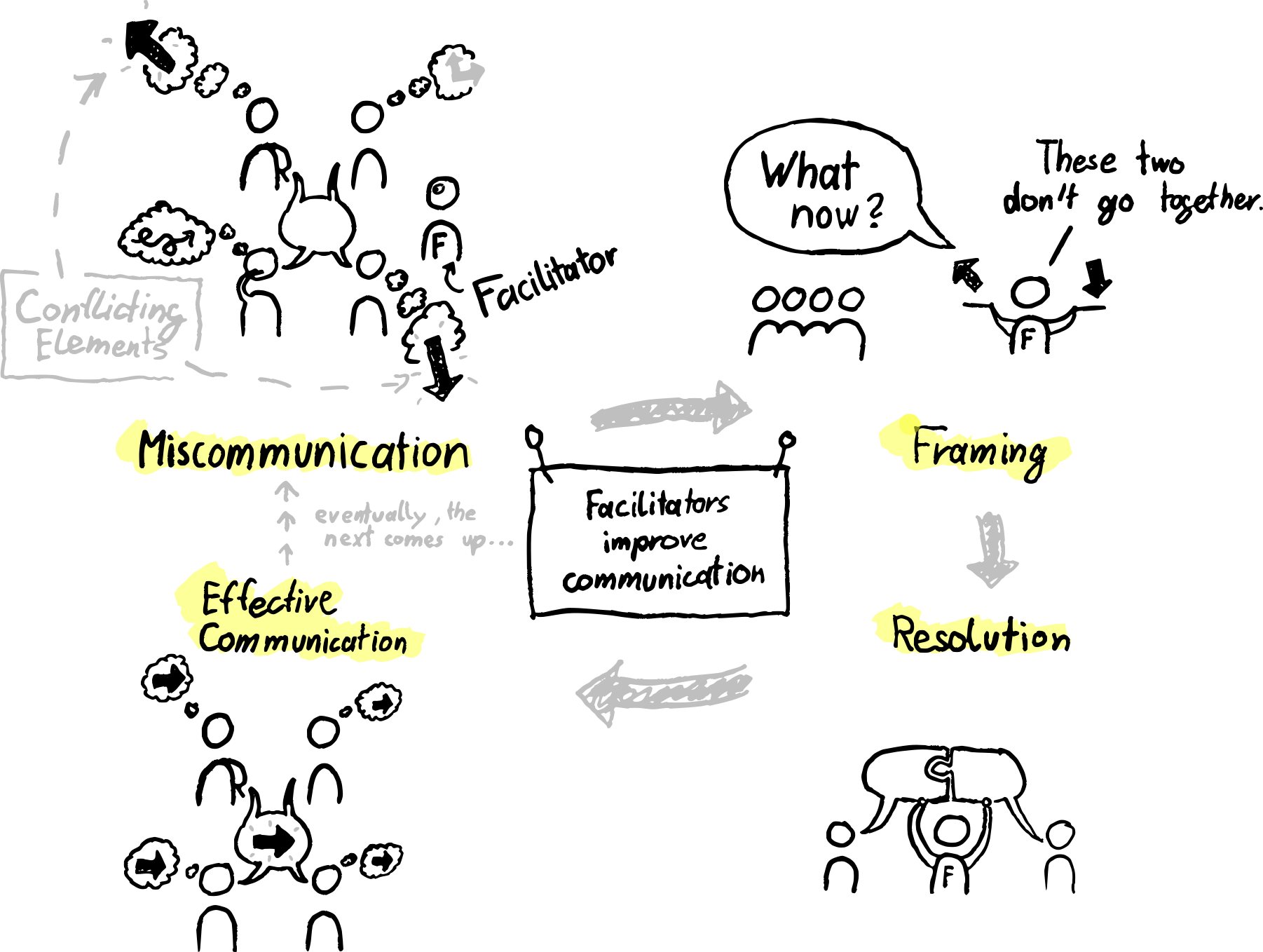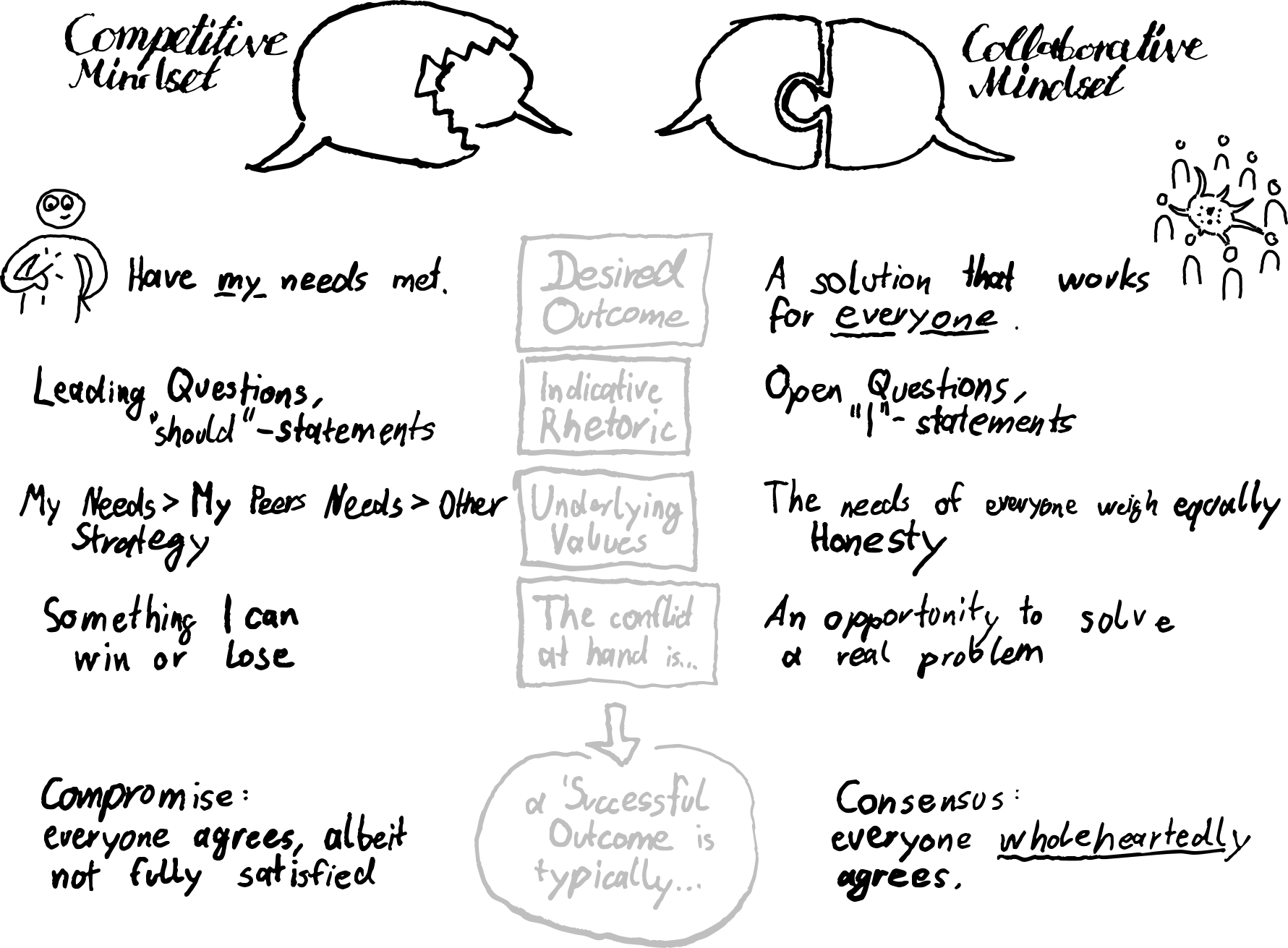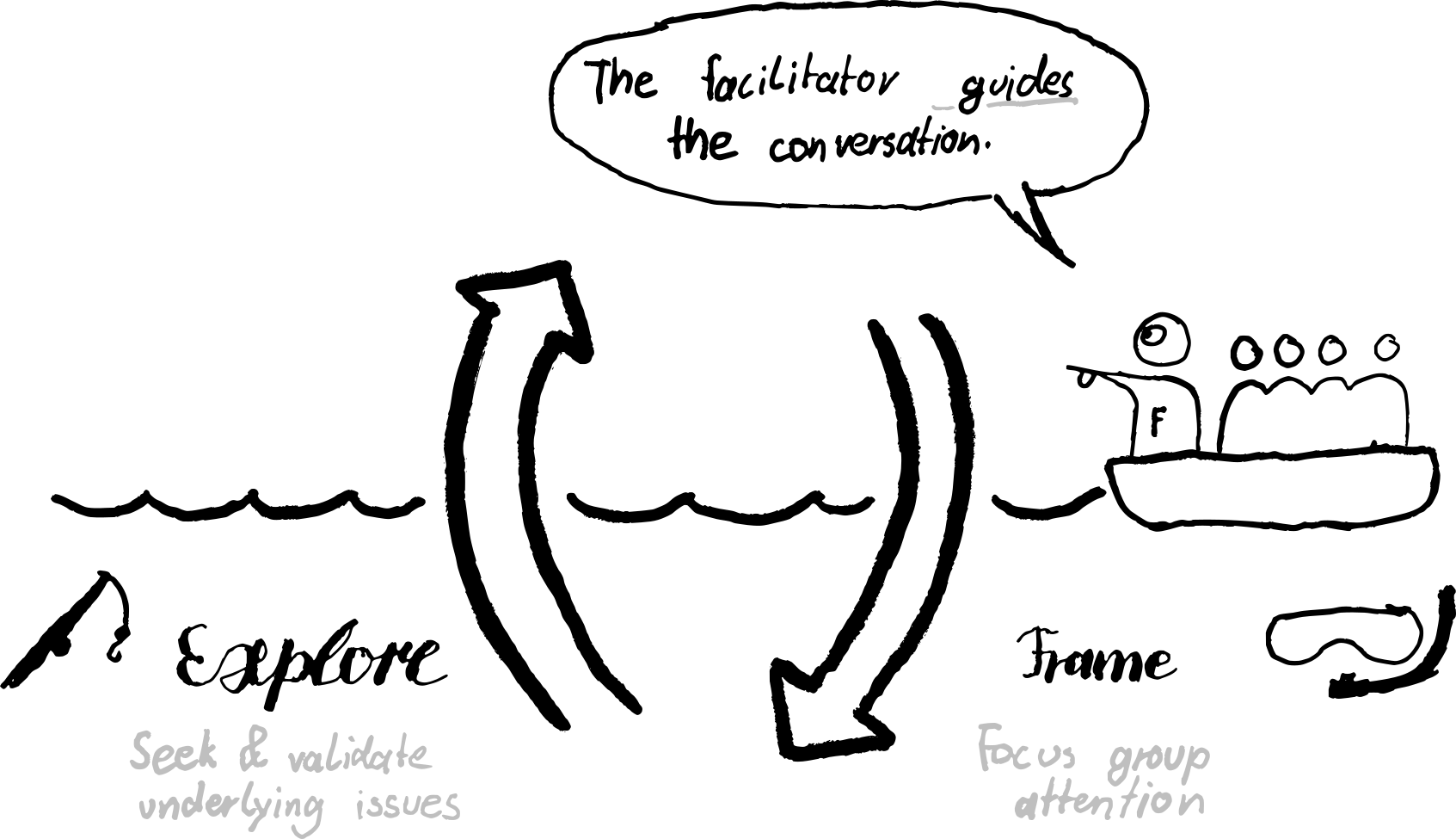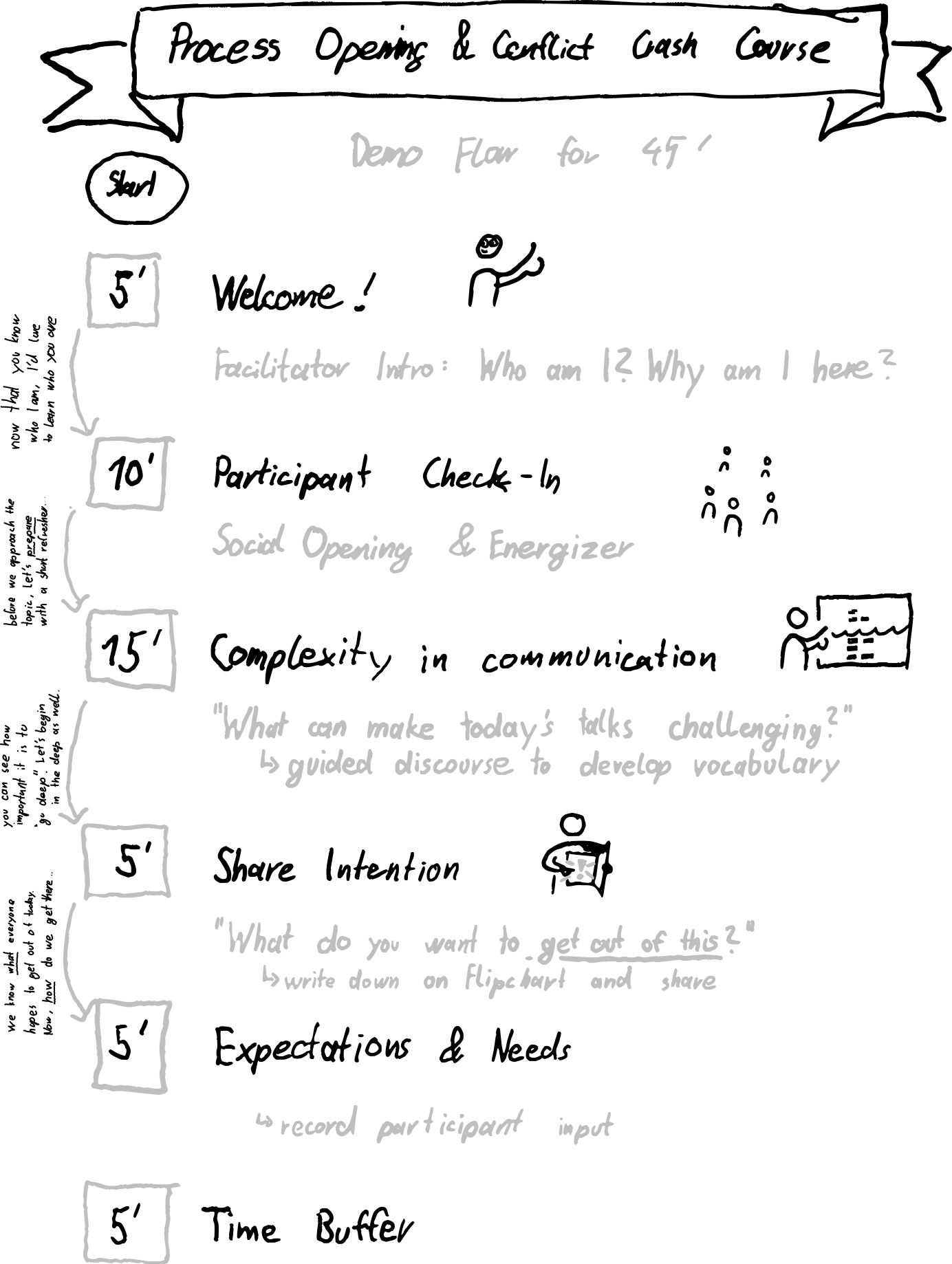The Conflict Crash Course
“Give me six hours to chop down a tree and I will spend the first four sharpening the axe.”
attributed to Abraham Lincoln
When I facilitate a process to help a group resolve a challenge, I dedicate at least the first 45 minutes to a concise training session on conflict management, no matter the previous experiences in the room. In this post, I outline my motivation for this as well as the core messages I found especially helpful to deliver before diving into the actual facilitated discussion.
Background: Conflict is Key
Conflict is a natural phenomenon within any group. Even when unaware or unaddressed, someone in the room is bound to disagree with someone else. This can express itself in many ways, for example:
- conflicting wants/needs, e.g. two departments require the same company resource to operate effectively
- conflicting beliefs, e.g. when NFT-optimists ("everything will be on the blockchain" vs. "this technology is a cash-grab") and -pessimists clash on business strategy
- conflicting values, e.g. when deciding between a profit-oriented or a community-oriented action
In an ideal scenario, conflict resolution can be spelled out simply:
- The facilitator (observing the discussion) suspects a Miscommunication, i.e. a situation where participants don't seem to 'get each other'.
- The facilitator shares their observation with the group and validates: Is this a miscommunication? If so, we want to talk about it. This way, the facilitator frames the conversation; making clear we now need to focus on the uncomfortable misalignment.
- Now that the potential conflict is the subject of everyone's attention, the group aims to resolve it with facilitation support.
- This leads to more effective communication, an absolute necessity for successful outcomes.
Or, in pictures:

Having had various opportunities to facilitate group processes, I found that after the resolution in which underlying conflicts are addressed constructively, participants report the feeling of a breakthrough-moment, 'real' progress being made. With the big win of having resolved a conflict in agreement comes also a significant emotional payoff after the discomfort of facing the conflict.
No matter if participants are conscious of a conflict or not, once it is addressed and resolved, participants tear down a real barrier to collaboration:
Conflict is the price of breakthrough progress.
The faster the underlying conflict is addressed (healthily), the faster the barrier can be resolved.
Or, to make this actionable:
Facilitators should pay attention to signs of conflict; they explore, identify and validate conflicts in the group, and frame the conversation to help the group resolve them.
Groups have an inherent opportunity to improve trust, collaboration, and overall effectiveness when seeking an inclusive solution. The required vulnerability and honesty leave lasting impacts in their memory and on their performance.
Preparing Participants to Manage Conflict
The conflicts stem from the participants; and only the participants can resolve them. I found the participants' mindset to be the most reliable predictor of success:

Of course, the facilitator desires participants that engage with each other from a collaborative, rather than a competitive perspective. In reality however, I found a majority of groups to default to competitive mindset when a challenge arises, often unaware of this. As the host, the facilitator however can influence the participants' mindset, providing an opportunity to set the right scene:
Shifting the group's mindset from competitive to collaborative engagement before intense discussions saves a lot of blood, sweat, and tears down the line.
The right pre-framing of participants can make the difference between talking at and speaking with each other.
Conflict Training: What to Deliver
The exact shape of any training depends on the specific group and their individual needs. However, I found that the following strategies are helpful for most groups.
The Tangible: Framing Complexity in Communication
Especially when working with less experienced groups, I find it helpful to dissect what's happening visibly and invisibly during discussions: Differentiating between words and intentions is difficult when emotions run high and getting everyone on the same page is best before someone says something they cannot take back.
Most importantly, I want participants to separate words and intentions. This graphic illustrates this with two layers and gives the group a shared vocabulary:

The visual metaphor can also be used to intuitively frame the job of the facilitator:

I would usually develop these graphics together with participants during a dialogue. A few realizations they tend to share here:
- There is a leap of interpretation between words used (surface) and the motivation behind. This is a possible source of miscommunication.
- A lot of time can be wasted on the 'surface' before the underlying, 'deeper' issue has been identified.
- It is more productive to focus on the 'deeper' elements than focusing on the actual words used (as opposed to what's happening during a debate).
- It's less important what we say (surface) and more important what we mean (sub-surface) in order to come to an agreement.
- Some rhetoric tools are more constructive than others: Our goal should not be convince others (e.g. nudge my counterpart to the desired response through rhetorical questions) but rather express my own needs and desire to understand others'.
These insights create awareness on the complexity of discussion and increase trust when the facilitator aims 'below the surface'. Participants can now more precisely label their own and (what they perceive to be) other's inner workings.
The Intangible: Fostering Constructive Group Culture
Finding the group's skeletons in the closet requires trust: More often than not, the style of a mediated conversation is unfamiliar to participants, requiring a decent amount of vulnerability both in front of the facilitator and also - probably more uncomfortably - in front of colleagues.
Unlike learning a shared vocabulary, I cannot create trust with flipcharts. Trust is deeper than knowledge and involves cultural tokens like values that are living and dynamic within the group; and many groups would rather leave a cautious distance or ignore them than explore them with vulnerability.
We do have a blueprint for internalizing values. In short: A person internalizes a value by engaging with people who live the value. This happens almost entirely unconsciously and is called Socialization.
And who will be the person that demonstrates the desired values? I'm sure you know the answer.
A facilitated space starts off in a "sociocultural vacuum": We don't know yet know "what kind of experience" this will be; whether it will be tense or light, personal or impersonal, deep or shallow.
The facilitator has the advantage of status and of first impression, filling the vacuum first and "setting the tone" for the experience.
I think it is difficult to overstate the importance of this: The facilitator lives and models the desired behaviors. Setting the standard for how to engage with others is not trivial, and I see moderators stumble here regularly.
Mind your Introduction
The first five minutes of the "sociocultural vacuum" are the most defining. The process is still a blank sheet of paper and anything could happen. What tone will you set from here? Will you talk about your qualifications and why you think you are the right person to facilitate this? Will you share a personal story? Will you ask participants first to share their goals or their concerns about this space?
I find setting a more detailed plan for the first five minutes reduces my stress immensely in the early moments (which admittably are the most frightening to me personally). I might set out concrete words/sentences I want to get across or prepare for the most likely objections I might face when setting the tone.
Check your "Do as I say, not as I do" attitude
Self-awareness is a gift that facilitators also only have limited amounts of. When facilitating, I might preach openness, but feel uncomfortable myself owning a mistake out of fear of what the group might think. This will affect the group's openness. Participants intuitively 'catch on' to the behavior I'm modeling and will feel inclined to be silent about their own mistakes, just as me owning a mistake and apologizing can inspire them to be vulnerable as well.
Unfortunately, there are no easy ways to fill awareness-gaps. After the fact, participant feedback (and supervision) is the most valuable gift to learn. I find self-accountability to be a helpful term here: During the facilitation, hold yourself to the same - and ideally a higher - standard as your participants.
Why > What
Author and speaker Simon Sinek summarized the core idea of one of his excellent TED talks on inspiring organizations as "People don't buy what you do, they buy why you do it." This certainly applies here.
When opening the space, I like to have participants check in sharing some form of personal Whys. Questions focused on purpose over pragmatism (e.g. Why are you here today? What do you hope our outcome will be 10 years down the line?) allow participants to share their intentions, setting up an open atmosphere. When everyone is aware of why we are here, discussing what the outcome will be less confrontational.
Cultivating Shared Ownership
Having talked about the importance of Socialization around values, there is one particular value I want to highlight, Ownership. Ownership does not relate directly to conflict, but I find the difference between group's that do and do not live this staggering.
The group lives the value ownership when they act from a sense of shared responsibility for the process and outcome.
When a group lives ownership and conflict emerges, there is a higher likelihood the group will seek a favorable outcome for everyone (i.e. consensus or compromise).
One of my favorite ownership tools are hosting slots: As a participant you can take over a short section of the process and take over the role of facilitator, e.g. a 20 minute post-lunch slot for reflection or getting energized.
An Actual Outline
The purpose this post is laying out ideas rather than instructions to a facilitator. Still, this would be incomplete without casting these thoughts into a concrete shape. Had I only minimal time to spare before starting the facilitated process in ernest, this is how I might prepare my participants:

An opening like this would at maximum take an hour away from the core discussion, but the difference when jumping 'in medias res' is palpable. It is hard to estimate the value of a solution-seeking group, seeing the difference however justifies the '~1h' price tag easily.
Using Lincoln's words once more, my facilitations plan space for sharpening the axe and it was a pleasure sharing one of my go-to whetstones. Feel free to use this to shape your own meetings and to find inspiration for your own conflict management tools.